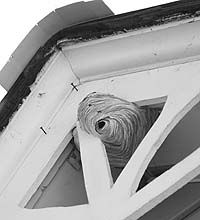| Bees in the eves is not always pleasant, but the fact that many commercial hives are collapsing could bode ill for world food supplies. Scientists are presently working on what is causing CCD. |
According to the United States Department of Agriculture, beginning in October 2006, some beekeepers began reporting losses of 30-90 percent of their bee hives. While colony losses are not unexpected during winter weather, the magnitude of loss suffered by some beekeepers was highly unusual.
This phenomenon, which currently does not have a recognizable underlying cause, has been termed “Colony Collapse Disorder” (CCD). The main symptom of CCD is simply no or a low number of adult honey bees present but with a live queen and no dead honey bees in the hive. Often there is still honey in the hive, and immature bees (brood) are present.
Government scientists and others are in the process of carrying out research to discover the cause(s) of CCD and develop ways for beekeepers to respond to the problem.
For some people bees are troublesome insects, but in fields of food production bees are responsible for pollinating many kinds of crops. Bee pollination is connected to $15 billion in added crop value each year, particularly for specialty crops such as almonds and other nuts, berries, fruits, and vegetables.
About one mouthful in three in the human diet directly or indirectly benefits from honey bee pollination.
While they are native to the United States pollinators (honey bees came from the old world with European colonists), honey bees are more prolific and the easiest to manage for the larger scale pollination that U.S. agriculture requires. In California, the almond crop alone uses 1.3 million colonies of bees, approximately one half of all honey bees in the United States, and this need is projected to grow to 1.5 million colonies by 2010.
The number of managed honey bee colonies has dropped from 5 million in the1940s to only 2.5 million today. At the same time, the call for hives to supply pollination service has continued to climb. This means honey bee colonies are trucked farther and more often than ever before.
Honey bee colony health has also been declining since the 1980s with the advent of new pathogens and pests. The spread into the United States of varroa and tracheal mites, in particular, created major new stresses on honey bees.
The loss of colonies could not only be costly for agriculture, but could raise the price of foods they help to produce since supplies of those crops are contingent on the bees activities.

